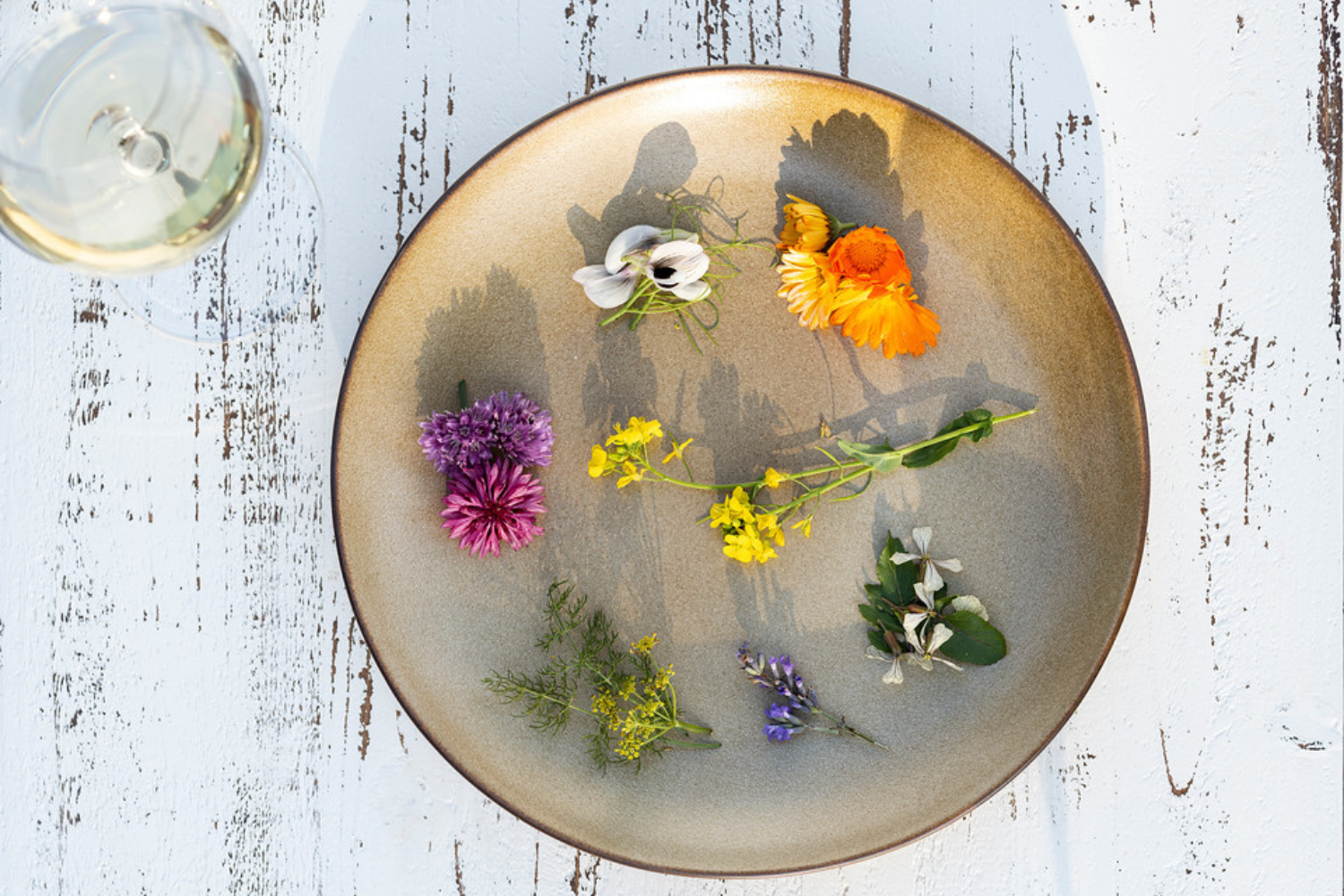Beautiful blooms popping up like parasols in the gardens and hillsides is the hallmark of springtime in Napa Valley. This is the season where showy displays of yellow, purple, and white flowers inspire you to take them into the kitchen and discover their boundless culinary charms.

From Calendula, with its marigold markings, to the unmistakable golden yellow petals of mustard, edible flowers can brighten dishes both in color and flavor. From fresh or dried, whole or as a condiment, infused in a syrup, raw, cooked, and even pickled: there are countless ways to enjoy them. Indeed, the world of edible flowers is vast and kaleidoscopic, but it needn’t be daunting. We have asked Chef Christina Machamer to help demystify the concept of cooking with edible flowers, drawing upon her decade of experience curating French-inspired fare with a California flair.
“My approach to edible flowers is the same as cooking with any other natural ingredient–don’t let anything you grow go to waste,” said Machamer. As a home-gardener and farm-to-table chef, that means finding edible flowers in her vegetable patch. “We might primarily grow these crops for another part of the plant–like arugula, fava bean, and chives–but their blossoms taste just as great,” said Machamer. Of course, for those of us whose green thumb capabilities are limited to potted plants on the windowsill, Machamer suggests purchasing an edible flower seed kit on Amazon to provide the basics for starting a personal flower garden.
Before trying your hand at growing and foraging however, remember to always wash flowers carefully before eating, don’t use anything bought at a florist as they are often loaded with pesticides or other chemicals, and never eat anything unless you can be sure that you have identified it correctly.
Here are several of Chef Machamer’s favorite homegrown edible flowers and her recommendations on how to use them.

Fennel Flower
Is bright yellow and known for its anise and licorice-like notes, similar to the herb. Typically in season from late winter to early spring, fennel flowers can be used to top of pasta primavera, roasted poultry, and seasonal soups.

Fava Bean Blossom
Have a light, nutty and earthy flavor that can be used in anything you would use fava beans or peas. “My favorite way to use fava bean flower is in my sweet pea risotto with lemon and asparagus,” said Machamer. “They make a decorative accent to such a spring-forward dish.”

English Lavender
Its purple hue and fragrant aroma make it immediately recognizable. It functions a lot like rosemary and has a strong, herbal flavor where a little goes a long way. “I prefer to use lavender in sweet preparations,” said Machamer. “Simply blend with equal parts sugar and water to make a delicious lavender infused syrup to macerate blueberries, whip into a frosting, or to add to a cocktail.”

Chive Blossom
Have whispy purple petals to contradict their garlic, onion flavor. “I recommend using them in preparations that are complemented by an onion note such as sprinkling them on top of a buttered steak or as a garnish on charcuterie boards,” said Machamer.

Arugula Blossom
Is great in both savory dishes and salads and can be used in dishes already incorporating the arugula flavor. “My husband and I were growing salad greens in our home garden, and it got away from us,” said Machamer. “But by letting a few arugula plants go to seed, it gave us these beautiful edible flowers that taste just like the herb.”

Calendula
Also known as the pot marigold, Calendula is part of the daisy family. Bright yellow and slightly bitter and peppery, the petals are ideal for adding color to a dish. It is best added to rice, poultry, and salads or as a tea. “The flavor profile can be more assertive than other flowers, so I like to add it to salads,” said Machamer. “The salad dressing will balance its bold flavors.”

Mustard Flower
This vibrant golden flower grows wild throughout Napa Valley from January to March and is a very important cover crop in our vineyards. Just like its ground up seed which makes the condiment, mustard, the flower and greens have endless versatility in the kitchen as well. Mustard flowers have a sharp, spicy flavor that complement many savory dishes. “As a Napa Valley chef, I’ve become very familiar with mustard flower and love to use it to garnish pork loin, sausages, bratwurst, chicken wings – pretty much anywhere I would use the condiment,” said Machamer.











